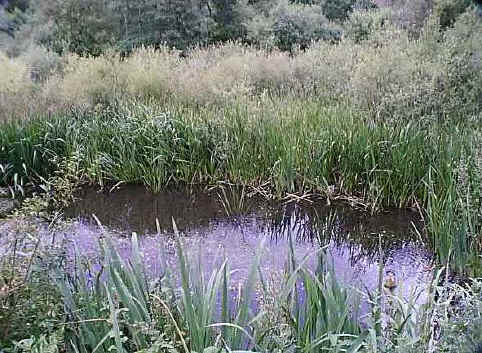The Wetland
 |
| The Wetland area was created in 1991/2 as part of the Wetlands Project. The area combines several different types of valuable freshwater habitat. These consist of an area with varying depths of water and a transition from still water to swamp, then marsh and then wet woodland. Prior to this the area had been a small boating lake which was established in about 1830 by the victorian cleric, Dr Copleston. By the time the restoration project took place the lake had completely silted up and rhododendron had become established. The dam wall had also been breached. Following clearance of rhododendron, the dam was repaired. The Wetland is fed by a stream entering from the north. The height of the dam was carefully engineered so that a transition was created from open water to dry land. Immediately by the dam spillway open water exists. These transition areas are particularly valuable for wildlife. Different plant species colonize the different depths of water and each supports a different range of animals. This means that wetland is a very rich habitat supporting a large variety of unique plant and animal life. Wetlands have largely disappeared across much of Britain due to the draining of agricultural land. Remaining wetlands such as this one are at a premium. Part of the Wetland is at a depth of 600mm, ideal for the thousands of toads which come here to breed every spring. Shallower areas of 300mm are more suitable for the breeding frogs which also visit in spring time. The Centre is a major amphibian breeding site which has been featured on the BBC and Network Television on several occasions. More about amphibians here. However the wetland areas are not only important for amphibians. Many plant and animal species are associated with wetlands. Inumerable different invertebrates from water fleas, to mayfly larvae and waterboatmen, live in the open water of the wetlands. The larvae of many species of dragonfly and damselfly also live in the clean freshwater of the wetland, feeding on the abundant invertebrate life. The Centre is regionally important as a breeding site for dragonflies. The Ruddy Darter which breeds at the Centre is known to breed at only one other locality in Devon. Nineteen species of dragonfly and damselfly have been recorded at the Centre. In summer, some of the larvae will crawl up plant stems until they are out of the water, emerging many hours later as spectacular flying insects. They may then be seen hunting and catching insect life in the air over and around the wetland. Many hundreds more invertebrates live amongst or on the emergent vegetation. Willows alone can support more than 400 different insect species. This provides an abundance of food for many birds of the Wetland, as well as those from neighbouring habitats. Acess information about wetland restoration and a detailed ecological survey here. |
Visit the Woodland Education Centre